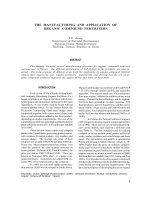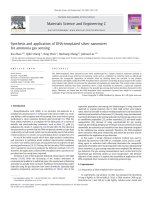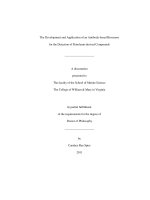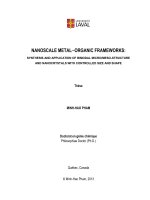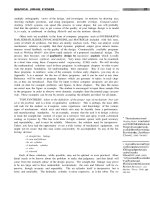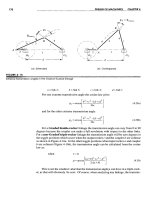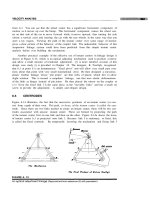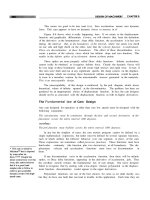The synthesis and application of energy storage materials derived from small molecules
Bạn đang xem bản rút gọn của tài liệu. Xem và tải ngay bản đầy đủ của tài liệu tại đây (2.44 MB, 66 trang )
THE SYNTHESIS AND APPLICATION OF
ENERGY STORAGE MATERIALS DERIVED
FROM SMALL MOLECULES
ZOU SHIQIANG
NATIONAL UNIVERSITY OF SINGAPORE
2014
THE SYNTHESIS AND APPLICATION OF
ENERGY STORAGE MATERIALS DERIVED
FROM SMALL MOLECULES
ZOU SHIQIANG
(M.Sc, Peking University)
A THESIS SUBMITTED
FOR THE DEGREE OF MASTER OF SCIENCE
DEPARTMENT OF CHEMISTRY
NATIONAL UNIVERSITY OF SINGAPORE
2014
Declaration
I
hereby declare that this thesis is my original work and
entirety, under the supervision
it
of Prof. Loh Kian Ping
has been written by me
in its
(Graphene Research Center),
Department of Chemistry National University of Singapore, between August, 2013 and July,
20t4.
I have duly acknowledged all the sources of information which have been used in the thesis.
This thesis has also not been submitted for any degree in any university previously.
Zou Shiqian
Name
s
Ztu
Cryry
Signature
An.>t
*
,
Date
?atV
Acknowledgements
I would like to dedicate this dissertation to my supervisor Prof. Loh Kian Ping, who has
offered me lots of guidance and support during my study and research period in NUS.
Besides, I’m also deeply inspired by Prof. Loh’s enthusiasm in exploring cutting-edge
scientific issues. That is the most important virtue that a true and ingenious scientist should be
equipped with.
Secondly, I owe a large part of my progress to Dr. Su Chenliang and Dr. Peng Chengxin. My
horizon is broadened by working together with these two brilliant brains. Their guidance and
support are highly appreciated as well. They should be regarded as my role model if I want to
devote myself to scientific research.
Besides, I want to give my special thanks to Su Jie, who has given me tremendous help in this
lab as a classmate and partner. All those time we spent at the GRC and fighting for success
will surely be precious memory to me. This young man’s devoted heart and logical mind
influence me a lot during our experiment time.
Sincere thanks to all the staff and all the members of our research group, especially Ms. Rika,
the warm-hearted research assistant, and Ms. Meng Xing. Not only do they offer important
assistance, but make my life in NUS more colorful and fruitful.
II
Finally, I should tribute to all the professors and staff of the SPORE committee. With your
unselfish and industrious effort, I can have this valuable chance to study in NUS and explore
Singapore. Indeed, I benefit hugely from this SPORE dual master program.
III
Table of Contents
PAGE
DECLARATION ................................................................................................................... I
ACKNOWLEDGEMENTS ................................................................................................II
TABLE OF CONTENTS .................................................................................................. IV
SUMMARY ........................................................................................................................ VII
LIST OF TABLES.............................................................................................................. IX
LIST OF FIGURES ............................................................................................................ X
PAGE
CHAPTER 1: LITERATURE REVIEW ........................................................................ 1
1.1 Fundamentals of Li-ion battery system ........................................................................... 1
1.2 Developments of anode materials in battery system ...................................................... 4
1.3 Inorganic anode materials ................................................................................................ 5
1.4 Organic anode materials ................................................................................................... 7
1.5 Objectives and scope of the dissertation .......................................................................... 9
IV
CHAPTER 2: ORGANIC ANODE MATERIAL DERIVED FROM SMALL
ORGANIC MOLECULAR FOR LI-ION BATTERY .............................................. 11
2.1 Background ...................................................................................................................... 11
2.2 Experiment scheme and approaches ............................................................................. 12
2.3 Results and discussion ..................................................................................................... 14
2.3.1 Synthetic approaches of PTCB...................................................................................14
2.3.2 Characterization of TCB and PTCB...........................................................................14
2.3.3 Electrochemical performance of TCB and PTCB .......................................................18
2.4 Extended application of PTCB in photocatalysis area ................................................. 25
2.4.1 Fundamentals of photocatalysis .................................................................................25
2.4.2 Principles of PTCB as a photocatalyst .......................................................................26
2.4.3 Experiment procedure of photocatalysis ....................................................................27
2.4.4 Photocatalysis performance of PTCB ........................................................................28
2.5 Conclusion and future work ........................................................................................... 30
2.5.1 Main conclusion ........................................................................................................30
2.5.2 Future work ..............................................................................................................32
CHAPTER 3: INORGANIC ANODE MATERIAL DERIVED FROM SMALL
ORGANIC MOLECULES FOR NA-ION BATTERY.............................................. 33
3.1 Background ...................................................................................................................... 33
3.2 Experiment scheme and approaches ............................................................................. 34
3.3 Results and Discussion .................................................................................................... 35
V
3.3.1 Preparation of nano Sb-carbon composite .................................................................35
3.3.2 Characterization of nano Sb-carbon composite ..........................................................36
3.3.3 Electrochemical performance of Sb-carbon composite ...............................................40
3.4 Conclusion and future work ........................................................................................... 43
3.4.1 Main conclusion ........................................................................................................43
3.4.2 Future work ..............................................................................................................44
CHAPTER 4: SUPPORTING INFORMATION ........................................................ 45
4.1 Reagents information ...................................................................................................... 45
4.2 Equipment information................................................................................................... 47
CHAPTER 5: REFERENCES ......................................................................................... 48
VI
Summary
Nowadays, people are paying increasing attention to energy and environmental issues.
Developing materials, which can be used in energy-related fields, are commonly recognized
as one of the most important human endeavors for sustaining growth.
In order to shine some light on potential approaches to energy-related issues, several kinds of
organic and inorganic materials, primarily derived from small molecules, were successfully
synthesized in this study and systematically investigated in energy-related application: Li-ion
battery, Na-ion battery and photocatalysis.
The results obtained indicates that the small organic molecule, 1,3,5-tri(9H-carbazol-9yl)benzene (TCB), is highly promising as a candidate material to be deployed as anode in the
lithium battery system. With high initial specific capacity (800-900 mAh/g), relatively stable
rate and cycling performance and nearly 100 % coulomb efficiency, the novel small organic
molecule, TCB, is a suitable anode material in Li-ion battery system.
The organic polymer, micro-wire polycarbazole (PTCB), which is primarily derived from
TCB, also presents some electrochemical features with relatively low specific capacity and
cycling stability. However, PTCB’s performance as a photocatalyst is outstanding. By using
acetonitrile as the solvent and providing adequate oxygen, the conversion rate and selectivity
achieve 100 % and 98 %, respectively, after 2 hours’ visible-light exposing. Obviously, PTCB
shows a bright future as an effective photocatalyst in photochemical synthesis. Thus, both the
VII
TCB and PTCB, as novel organic materials, would contribute much to energy-related
applications.
The novel inorganic Sb-carbon composite, which is derived from small organic molecule
(triphenylstibane), presents excellent electrochemical performance as the anode material in
the sodium-ion battery system. Containing carbon (52 %) and antimony (35 %), this material
exhibits large specific capacities (800 mAh/g @ 1C, 630 mAh/g @ 2C and 580 mAh/g @ 4C).
Besides, it displays rather stable performance and high (>99%) coulombic efficiency under
different rates. Thus, this material is highly promising for application in sodium-ion battery.
VIII
List of Tables
PAGE
TABLES
Table 1.1
Theoretical gravimetric and volumetric specific capacities of
6
Li-alloying elements
Table 3.1
Elemental analysis of Sb-carbon composite at different
40
temperatures
Table 4.1
All the reagents used in this study
45
Table 4.2
All the equipment used in this study
47
IX
List of Figures
FIGURES
Fig. 1.1
PAGE
Illustration of the charge/discharge processes in rechargeable
2
Li-ion battery
Fig. 1.2
The redox mechanisms of three types of organic materials
8
Fig. 1.3
Typical inorganic/organic electrode materials and their
8
corresponding redox voltage and specific capacity for
rechargeable lithium batteries
Fig. 2.1
Novel organic polymers containing conjugated amine
11
structure and their theoretical specific capacity
Fig. 2.2
The schematic of the main chemical reaction in PTCB
12
synthesis
Fig. 2.3
The experiment scheme of chapter 2
13
Fig. 2.4
TGA result of TCB
15
Fig. 2.5
TGA result of PTCB
15
Fig. 2.6
FTIR spectrum of TCB and PTCB
16
Fig. 2.7
SEM image of PTCB
17
Fig. 2.8
UV absorbance spectrum of TCB and PTCB
17
Fig. 2.9
Cyclic voltammogram (CV) curve of TCB
20
Fig. 2.10
Cycling performance of TCB
20
Fig. 2.11
Charge-discharge curve of TCB
21
Fig. 2.12
Rate performance of TCB at different rates
22
Fig. 2.13
Cyclic voltammogram (CV) curve of PTCB
23
Fig. 2.14
Cycling performance of PTCB
24
Fig. 2.15
Charge-discharge curve of PTCB
25
Fig. 2.16
The schematic diagram of PTCB-based photocatalysis
27
X
Fig. 2.17
The schematic diagram of photocatalysis when PTCB worked
28
as the catalyst and benzylamine worked as electron donor
Fig. 2.18
Photocatalysis reaction when benzylamine served as electron
28
donor
Fig. 2.19
The conversion rate and selectivity of PTCB, graphene-C3N4
30
and TiO2 for photocatalysis experiment
Fig. 3.1
The experiment scheme of chapter 3
35
Fig. 3.2
The macro-surface structure of the Sb-carbon composite
36
Fig. 3.3
Transmission electron microscopy (TEM) picture of the Sb-
37
carbon composite (side view)
Fig. 3.4
TEM picture of the Sb-carbon composite (top view)
37
Fig. 3.5
The spherical structure of Sb-carbon composite (low
38
magnification)
Fig. 3.6
The spherical structure of Sb-carbon composite (high
38
magnification)
Fig. 3.7
X-ray diffraction (XRD) of Sb-carbon composite
39
Fig. 3.8
Raman spectrum of Sb-carbon composite
39
Fig. 3.9
CV curve of Sb-carbon composite
42
Fig. 3.10
The specific capacity and coulombic efficiency of Sb-carbon
42
composite in Na-ion battery
Fig. 4.1
The 1H NMR spectrum of TCB (CDCl3, 300 Hz)
46
Fig. 4.2
The 13C NMR spectrum of TCB (CDCl3, 300 Hz)
46
XI
Chapter 1: Literature Review
Nowadays, people are paying increasing attention to energy and environmental issues.
Scientists from all over the world try their best to enhance the electrochemical performance of
current energy storage techniques and explore new energy sources as well as energy-related
materials with outstanding performance [1, 2].
Efficient and portable energy storage
equipment and devices hold the key to the future development of human society. The
electrode is an essential part of the battery system and is absolutely vital in the improving
current energy conversion efficiency of batteries. Due to the deterioration of current
environment and increasing awareness of protecting earth, attentions are now focused on not
only the electrochemical performance of certain electrode material, but also the safety issues,
cost-effectiveness and environmental friendliness [3].
1.1 Fundamentals of Li-ion battery system
The first Li-ion graphite electrode was manufactured in Bell Labs. The Li-ion battery was
later commercialized by Sony Company in 1991. In this battery, exchanging of Li+ is realized
between graphite (LixC6) anode and a layered-oxide (Li1-xTMO2). TM stands for transitional
metal, such as cobalt, nickel, manganese, etc [4].
Li-ion battery, like all the other batteries, consists of two electrodes: cathode and anode.
These two electrodes are connected by electrolyte. Different chemical reactions happen on
1
these two electrodes. Once connected by external devices, electrons will flow from the
negative-potential electrode to positive-potential electrode. In order to balance the charge, the
ions inside the electrolyte will move accordingly. On the other hand, a larger voltage is
required in the opposite direction to force the battery into the recharge phase [2].
Typically, following reactions (Fig. 1.1) occur in the Li-ion battery (LiCoO2 as cathode and
LixC6 as anode):
Charge
Li1-x CoO2 +Li + +xeCathode: LiCoO2
(1-1)
Charge
Li x C6
Anode: 6C+xLi + +xe-
(1-2)
Charge
Li1-x CoO2 Li x C6
Overall reaction: LiCoO2
(1-3)
Discharge
Discharge
Discharge
Fig. 1.1 Illustration of the charge/discharge processes in rechargeable Li-ion battery
Currently, inorganic and organic electrode materials are both used in battery systems.
Inorganic electrode materials have been thoroughly studied for decades and are widely
2
implemented in practical devices and commonly used in our daily lives. For example, LiCoO2,
LiNiO2, LiMn2O4, LiNi1/3Co1/3Mn1/3O2 and LiFePO4 are usually used as the inorganic cathode
materials in lithium system. All inorganic materials mentioned above exhibit a theoretical
specific capacity less than 300 mAh/g and a practical specific capacity below 170 mAh/g.
One drawback is that inorganic transition metal-containing electrode consumes elements that
are not earth abundant and leads to corresponding environmental concerns with its use and
disposal [5].
As for organic electrode material, more investigations are needed in the laboratory scale to
design novel electro-active organic molecules and stabilize their performances. Actually,
lithium organic battery can be traced back to 1969 [6], which is close to the time when lithium
battery was invented [7]. In order to compete with inorganic electrode, scientists have tried
endeavored to design different organic structures and redox mechanisms to achieve a higher
performance for a prolonged time. For cathode materials, during the 1980-2000, conducting
polymers and organodisulfides were popular organic electrode for Li-ion battery, even though
their electrochemical performances are barely satisfactory [8]. After entering the 21st century,
the focus was shifted to nitroxyl radical polymers and conjugated carbonyl compounds [9]. As
for the anode materials, a few recent reports were focused on carbonyl-based organics [10,
11], dilithium rhodizonate and oxocarbons [5]. Recently, two organic salts, Li2C8H4O4 and
Li2C6H4O4 were reported as the organic anode materials with redox potential at 0.8-1.4 V [12]
3
with a reversible capacities of 300 and 150 mAh/g, respectively. Although the energy density,
cycling performance, stability and rate performance of certain organic electrode may be
superior to those of previous inorganic ones, a huge gap still exists between laboratory scale
investigation and massive industrial production.
1.2 Developments of anode materials in battery system
Typically, anode materials in the battery system can be divided into three groups regarding
their energy storage mechanisms: insertion type, conversion type and alloying-based type.
Most commercially applicable anodes are insertion type. They are usually made up of
transition metal oxides and graphite, which present excellent mechanical and electrochemical
stability. However, the relatively lower theoretical specific capacity of transition metal oxides
and the limited electrolyte choices partially hinder their further development.
In the conversion-reaction type materials, the transitional metals in the compound can be
replaced by Li [13-15]. For example, MnO will be reduced to Mn when lithiation happens,
which oxides the Li to LixO. However, the theoretical specific capacity and the Li-ion
mobility are relatively low. Moreover, larger polarization and voltage window for
lithiation/delithiation will eventually reduce the energy density [16].
As for the alloying-based type anodes, they usually alloy with Li under electrochemical
reactions. This type of anodes possesses higher charge capacity. The drawbacks are relatively
low Li-mobility inside the alloy, low rate capability and limited cycle life [16].
4
1.3 Inorganic anode materials
The inorganic anode materials mainly discussed here are from the alloying-based type. All the
Li-alloying elements’ theoretical and gravimetric specific capacities are shown in Table 1.1
[16].
As can be seen from this table, there are a wide selection of metal elements can be used as the
anode material with different specific capacities and price.
In order to choose the most suitable anode material, a series of factors need to be considered:
high theoretical capacity, easy availability, high conductivity, relatively low environmental
impact and most importantly low cost.
Si has been thoroughly studied as anode for years due to its large theoretical capacity [17-19],
with a maximum theoretical specific capacity of 3579 mAh/g [20, 21]. Si anode has also been
studied extensively regarding its strengths and drawbacks. Recent studies on Si anode focused
on fabricating nanostructure, such as Si nanoparticles [22-26] and porous nanowires [27].
Some of these anodes even achieve stable performance over 1000 cycles [28-30]. In addition,
carbon-silicon composites, such as graphite-Si layers [31], C-coated Si nanoparticles [32],
porous Si-C spheres [33], all achieve excellent performances.
5
Table 1.1 Theoretical gravimetric and volumetric specific capacities of Li-alloying elements
Atomic
Number
6
C
Gravimetric Specific
Capacity a
372
Volumetric Specific
Capacity b
756
Price in the past
5 years c
-
13
Al
993
1383
0.5-1.5
14
Si
3579
2190
0.7-1.2
15
P
2596
2266
-
30
Zn
410
1511
0.5-1
31
Ga
769
1911
100
32
Ge
1384
2180
500
33
As
1073
2057
1
47
Ag
248
1368
200-500
48
Cd
238
1159
1
49
In
1012
1980
150-350
50
Sn
960
1991
5-15
51
Sb
660
1889
3-7
79
Au
510
2105
10k-30k
82
Pb
550
1906
0.5-1
83
Bi
385
1746
8-12
Element
a The unit of gravimetric specific capacity is mAh/g.
b The unit of volumetric specific capacity is mAh/cm3.
c The unit of price is USD/lb.
Though it is much more expensive (according to Table 1.1), Ge has become increasingly
popular because of its excellent conductivity and lithium diffusivity as compared to Si.
Recently, the 500 nm Ge particles [34], 200 nm Ge sheets @ graphene [35] and 3-100 nm
nano-Ge [36-41] were all tested in the lab-scale systems with stable cycling and rate
capability.
Instead of its elemental form, SnO has drawn more attention from scientists. Although its
gravimetric specific capacity is lower than Si, the volumetric capacity of Sn is claose to the
6
latter one, Si. Nonetheless, the elemental form of Sn cannot achieve a stable cycling
performance [42], whereas Sn oxides can present a high capacity of 1000-1400 mAh/g [43].
However, Sn can also be used as anode in the form of Sn/Co/C, which is commercialized by
Sony Company and presents excellent cycle performance.
Lastly, Sb has always been considered as a potential anode candidate because of its high
theoretical capacity (660 mAh/g) and relatively low cost. Therefore, scientists are
investigating various kinds of Sb anodes, such as Sb nanocomposites [44-47], bulk
microcrystalline powders [48], Sb films [49]. Similar to carbon, Sb can display impressive
electrochemical performances as well, such as Sb/C fibers [50], Sb/C nanocomposites [51],
Sb/C nanotubes [52] and Sb/C thin films [49]. As a promising anode, Sb definitely can make
great progress as a novel alloying-type (fully lithiation form as Li3Sb) material.
1.4 Organic anode materials
Organic electrode materials are less popular in practical application largely due to their
apparently poor electrochemical performance and specific capacity. However, owing to
deeper understanding of the mechanism and continual improvement in the design of novel
organic molecules, some lab-scale organic materials seem promising and may have bright
future in industrial applications.
7
All organic electrodes can be divided into three groups, namely: p-type organics, n-type
organics and bipolar organics. The redox mechanisms of all three groups of organics are
shown in Fig. 1.2.
Fig. 1.2 The redox mechanisms of three types of organic materials: (a) n-type; (b) p-type; (c)
bipolar (derived from reference [53])
Fig. 1.3 shows some typical inorganic/organic electrode materials and redox voltage and
specific capacity for rechargeable lithium batteries. Because most of the redox potentials for
organics ranged from 2.0 to 4.0 V, they are more likely to be applied as cathode than anode.
Fig. 1.3 Typical inorganic/organic electrode materials and their corresponding redox voltage
and specific capacity for rechargeable lithium batteries (derived from reference [53])
8
Few organic anode materials are reported, including bipolar types [54, 55] and conjugated
dicarboxylates [12, 56-59]. For small organic molecules, many can achieve satisfying
discharge capacity and energy density. However, all small molecules substances are
confronted with the dissolution problem and poor cycling performance. Compared to
monomers, organic polymers are insoluble in most of the electrolyte. Thus, some scientists try
to solve the dissolution problem by polymerization. The polymers, unfortunately, have other
drawbacks, such as reduced theoretical specific capacity, enlarged electrochemical
polarization and lower ion mobility.
However, there is no denial that organic anodes, regardless of small molecules or polymers,
possess a myriad of advantages over conventional inorganic ones: higher energy and power
density, structure diversity (by design), flexibility (more methods to fabricate with different
morphology at the molecular level), sustainability (more accessible and no use of transitional
metals), cheap and better dissolution condition (especially for organic polymers).
1.5 Objectives and scope of the dissertation
High-performance and environmental friendly materials in the energy-related applications are
critically needed to fulfill the increasing energy demand in our modern society. However, few
studies are targeted on organic Li-ion anode material and inorganic Na-ion anode material
derived from small molecules. In this thesis, lab-scale synthesis and preparations are
conducted to obtain organic and inorganic materials, which are polycarbazole and Sb-carbon
9
composite, both derived from small molecules for energy-related applications. Thorough
characterizations together with investigations regarding electrochemical performance are
studied in lithium-ion and sodium-ion battery systems. In addtion, extended application of
PTCB as potential photocatalyst is explored to determine whether it can be utilized as a
multifunctional material.
The specific goals of this thesis are:
1.
Upon obtaining the organic monomer, 1,3,5-tri(9H-carbazol-9-yl)benzene (TCB), novel
polycarbazole material (PTCB) containing amine moieties is successfully synthesized
and thoroughly characterized. Both the electrochemical performances of organic
monomer and polymer are tested in the lithium-ion battery systems as the anode.
2.
PTCB’s photocatalytic potential is investigated and systematically optimized. The
possibility of polycarbazole serving as multifunctional material is scrutinized as well.
3.
Inorganic Sb-carbon composite derived from small organic molecules is investigated for
its electrochemical performance in sodium-ion battery system. The cycling behavior,
rate capability, specific capacity and charge-discharge performance of this inorganic
material are thoroughly studied.
10
Chapter 2: Organic anode material derived from small organic
molecular for Li-ion battery
This chapter was targeted at synthesizing a novel organic polymer, which is derived from a
small organic monomer, 1,3,5-tri(9H-carbazol-9-yl)benzene (TCB). Further investigation
regarding the small molecule (TCB) and its polymer’s electrochemical performance was
conducted to explore their potentials in practical lithium-ion battery systems. The PTCB’s
performance as a photocatalyst was further evaluated.
2.1 Background
The conjugated amine structure has already been investigated extensively as cathode material
in the previous studies [60-63]. Recently, two new types of conjugated amine were reported,
which are shown in Fig. 2.1.
Fig. 2.1 Novel organic polymers containing conjugated amine structure and their theoretical
specfic capacity: polytriphenylamine (PTPAn) and poly(N-vinylcarbazole) (PVK).
11
Both of them are categorized as n-type organic materials and thus are applied as the cathode
material in battery systems. Although the PTPAn presents low theoretical specific capacity, its
rate capability and cycling performance are excellent [64]. As for PVK, the specific capacity
is a little bit higher than PTPAn when applied as the cathode material [65]. Though no
previous studies have ever been done, we hypothesized that conjugated amine together with
benzene ring might possess the possibility to receive electron and served as the anode.
2.2 Experiment scheme and approaches
The small organic molecule, 1,3,5-tri(9H-carbazol-9-yl)benzene (TCB), was commercially
available from Sigma Aldrich (Singapore). The polymer, poly-TCB (PTCB) was further
synthesized through a modified method of the one used by Chen [66] (Fig. 2.2).
N
N
N
N
N
N
FeCl3, CH3Cl
N
N
N
R. T.
N
N
N
Fig. 2.2 The schematic of the main chemical reaction in PTCB synthesis
Upon the acquirement of both TCB and PTCB, a series of characterizations were applied to
determine the substance, investigate the microstructure and other features. The scheme is
shown in Fig. 2.3. The Ultra-shield 300 Hz nuclear magnetic resonance (NMR) spectrometer
12
